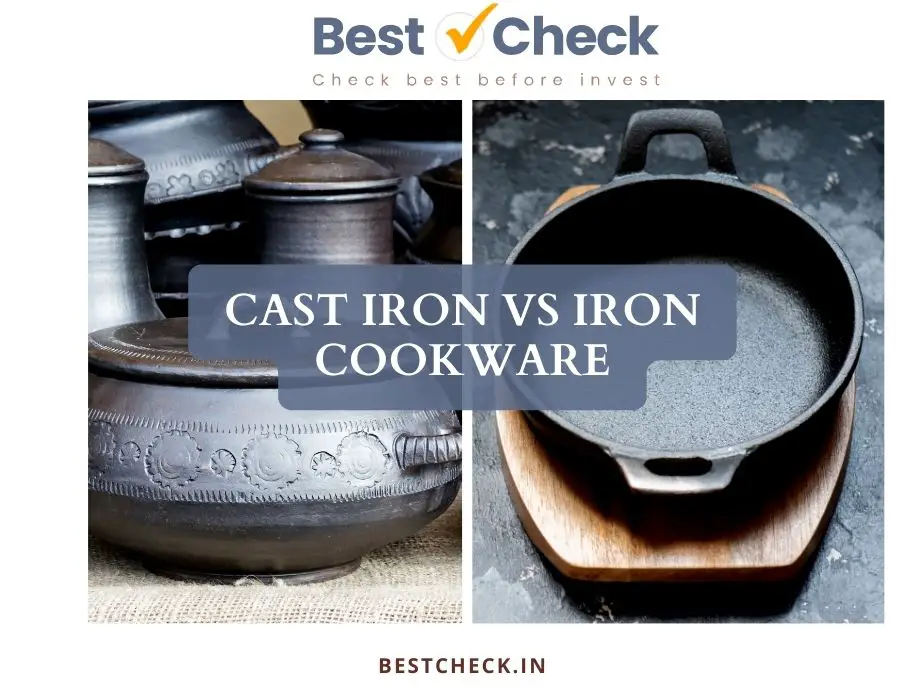Cast Iron vs Iron – Are They Same? Know Here The Difference

When it comes to cookware, the material used significantly affects both the manner of cooking and the final result of your dishes. Amongst myriad choices in the market, one couple is often quoted: iron and cast iron. You need to know the difference between iron and cast iron to make an informed choice; which will serve you best and your culinary needs.
Iron is a chemical element that is strong, malleable, and highly conductive. Therefore, it is likely to be a common choice in most object manufacturers, including some types of cookware. On the other hand, cast iron is a mixture of iron combined with carbon and silicon, including other elements that give it a variety of properties.
It’s very important to understand these differences when people ask the question of the type which is better for cooking, cast iron vs iron? Each of the materials certainly has certain unique benefits and can certainly influence the taste, texture, and healthiness of food cooked in them. Now, with all this knowledge of these materials, always remember which is the right kind of cookware to be used in your kitchen, and have a blast cooking delicious food with it.
1 Iron vs Cast Iron - Basic Definitions and Properties
What is Iron?
Iron is the basic element symbolized by the letter Fe and atomic number 26 according to the periodic table. It is characterized as hard and malleable, conducting both heat and electricity efficiently. Iron is the most plentiful element on Earth and is rarely found as a pure metal, reacting instead to form iron oxides. This kind of metal is greatly used by many industries, not only in the creation of kitchenware and utensils but even in construction, automotive, and manufacturing because of its high structural integrity and flexibility.
What is Cast Iron?
Cast iron is more of a family of iron-carbon alloys with a carbon content of over 2 %. In this kind of matrix, cast iron will portray great characteristics of highly resistant wear, improved durability, and high heat retention properties. On the other hand, the human-oriented view encompasses the melting of parts of iron with the necessary elements, including carbon and silicon, to come up with cast iron. The mixture is then poured into different moulds, depending on the shape, and then allowed to cool down. The high carbon content, which differentiates the difference between iron and cast iron, also makes cast iron even more brittle and less malleable than the high ductility exhibited by its pure iron counterpart.
2 Iron vs Cast Iron - Key Differences
Composition and Production
The very basic difference between iron and cast iron is the composition itself. Pure iron is an element rather soft and very ductile. Cast iron is an alloy of 2-4% carbon, with small amounts of silicon and manganese, often having trace impurities of sulphur and phosphorus. Such a difference in composition gives rise to dramatic effects on everything from the melting point to how the material can be used.
It has to be mined, extracted, and refined in a furnace through smelting a process that leads to the removal of impurities. This treated iron may further be processed to build different types of iron-based materials, for example, steel and cast iron. To produce cast iron, the refined iron is re-melted and combined with carbon and other elements, then poured into moulds to harden. This further step of alloying and mould-casting is exclusive and to some extent showcases the difference between both.
Physical Properties
Cast iron presents a much harder and more brittle material, as it contains much more carbon than pure iron. This shows that cast iron is less likely to deform under stress but is more likely to crack from a single hammer blow.
Then, cast iron usually will need more general care, especially from rusting, to be retained as a non-stick. It normally needs seasoning (heating and oiling to create a protective layer) from time to time, while iron may need quite a bit less care depending on use and the environment.
Thermal Properties
Cast iron excels in heat retention, which makes it ideal for cooking applications where even and consistent heat is necessary, such as searing meat or slow-cooking stews. Its ability to maintain temperature can enhance flavour development and cooking efficiency. However, iron conducts heat faster but does not retain it as long, making it potentially better for applications requiring rapid heating and cooling.
The iron and cast iron differences in thermal properties also influence their suitability for various cooking methods. Cast iron is preferred for its ability to withstand and maintain very high temperatures, making it ideal for baking and frying. In contrast, iron might be chosen for tasks that require quick temperature adjustments.

3 Iron vs Cast Iron - Advantages and Disadvantages of Cooking
Benefits of Using Cast Iron for Cooking
This is one of the best reasons which tells why one should go for cast-iron cookware. It brings an incredible flavour to your food. A natural non-stick coating developed on the surface of seasoned cast iron cookware also helps in flavouring the food prepared in it. What’s more, cooking with cast iron can help increase the nutritional value of food. It’s known to leach small amounts of iron into food, which really can be a plus for anyone, more so those who have deficiencies in iron.
Cast iron is also praised for being very durable and versatile. Cast iron cookware, when properly taken care of, may even be passed down to several generations—economical in the long run. It can be used for so many methods of cooking, from stovetop to oven and broiler.
Limitations and Challenges with Iron Cookware
Pure iron cookware does have its place, but they do present some drawbacks. Pure iron is more reactive than cast iron, as it has a greater reactivity towards moist and acidic foods which may attack and damage it easily. This reactivity can also lead to food sticking to the pan unless it’s well-seasoned—an attribute that many people who prefer low-maintenance kitchen tools may find less than ideal.
From a maintenance point of view, pure iron cookware more often requires seasoning and drying with fine detail to avoid rust, unlike cast iron. This might be taken as a big disadvantage by some of the users, underlining the practical benefits of choosing cast iron over pure iron.
4 Iron vs Cast Iron - Which is Better for Cooking?
After learning about cast iron and iron cookware separately, the question arises of which one is better. To help you answer, we have considered a few factors to know the difference between cast iron and iron cookware. Let us explore these factors.
Cooking Time
Cooking time is the first and most basic thing to consider while comparing cast iron cookware with iron utensils. Cast iron utensil is the best for slow cooking, and it is preferable if you are planning to cook a dish that takes a long time to prepare. Cast iron doesn’t burn the food because it heats the food evenly.
Iron cookware, on the other hand, heats up quickly and might burn the food. Slow cooking in iron cookware is thus not possible, and such cookware is recommended to be used for a dish which doesn’t take a long time to prepare and saves fuel.
Durability
Iron utensils are malleable, on the other hand, cast iron cookware is non-malleable. That is why pure iron utensils are more durable than cast iron utensils.
Non-stick Surface
While both cast iron utensils and pure iron cookware have naturally non-stick surfaces, cast iron cookware gets better after natural seasoning. Because of this, properly seasoned cast iron cookware requires less oil than wrought iron cookware. Iron cookware also heats quickly, and that can disturb its naturally non-stick surface.
Iron Imparting
Food becomes iron-enriched when cooked in either cast iron or iron cookware. However, because iron cookware is purer in nature, the quality of iron released in food from iron cookware is more and better. Iron-rich food is highly beneficial for everyone because it plays an important role in the formation of blood cells and boosts your immune system. Therefore, anaemic people should definitely consider cooking food on iron cookware daily.
Heat Retention
It is more durable to use cast iron cookware over high flames than iron cookware since iron cookware tends to expand under high heat. Because of this reason, cast iron cookware is also best for slow cooking, and it also keeps the food warm for a long time.
Rust
Because of the pure and raw material in pure iron cookware, iron utensils tend to suffer from rusting problems. In contrast, cast iron cookware does not rust easily. It has a composition of alloys which does not contain pure iron; These cookware materials prevent rusting. We also recommend seasoning and re-seasoning cast iron utensils with a thin layer of oil to avoid the rusting issue.
Heat Distribution
When compared to iron cookware, cast iron cookware provides better heat distribution because it distributes heat evenly.
Eco-friendly
Because of the fact that cast iron cookware provides even heat distribution, it is more eco-friendly as once heated, the temperature is evenly circulated. This avoids high flames while cooking. Also, cast iron skillet or any other cookware remains hot and keeps the food cooked warm for a long time so that you do not have to reheat it again and again.
However, pure iron cookware needs high flames to cook food, which uses more gas or electricity.
Maintenance
It is true that seasoning and storing cast iron cookware takes practice to maintain. However, iron vessels are difficult to clean as they tend to leave tough black stains after cooking. It is comparatively very easy to clean cast iron utensils.
Versatile Source of Heat
Cast iron vessels are compatible with induction, electric stoves, campfires and gas stoves. They can be used in a variety of heat sources to cook food. However, iron utensils are only compatible with open flame heat sources.
Portability
Using iron utensils is like having an arm workout every day. Iron vessels are heavier if compared to cast iron utensils. More weight of iron cookware also makes it difficult to store or shift them regularly.
Cast iron vessels, on the other hand, are comparatively lighter in weight and, therefore, easier to use.
5 Cast Iron Utensils or Iron Cookware - Which to choose?
Cast iron vs iron, which one is the best? Well, after learning about the different characteristics and features of both cookware, our personal choice is to use cast iron cookware. Cast iron cookware has plenty of health benefits including more heat retention, provides even heat distribution, is lighter in weight and easier to maintain. However, we won’t completely discard the idea of using iron utensils. There are many health benefits of cooking with iron utensils such as iron tawa, iron kadhais and iron pots, especially for Anaemic people with iron deficiency. Also, iron utensils are more durable than cast iron cookware. Additionally, while cooking acidic foods in cast iron utensils doesn’t define healthy cooking, cooking acidic foods in iron cookware is ideally recommended.
6 Wrapping Up
Finally, when considering the iron and cast iron differences, each has unique cooking properties to the other. Iron heats and cools very quickly, making it ideal for those who need to change the temperature very quickly. With the ability for slow cooking and baking, cast iron is exceptionally long-lasting and good at keeping heat. Generally, the decision lies between cast iron and iron according to individual style and requirements, where cast iron is the best for flavour and longevity and iron is for speed and responsiveness. Consider your cooking habits and maintenance willingness when choosing your cookware. Materials can greatly enhance your culinary experiences. If you want to buy cast iron cookware, check out our article on the best cast iron cookware in India. With this, we wish you happy, healthy cooking!
FAQs about Iron vs Cast Iron
Which is better cast iron or iron?
Cast iron is generally better for cooking due to its ability to retain and distribute heat evenly, making it ideal for tasks like searing meat or slow-cooking stews. Iron, typically referring to pure iron, is less common for cookware due to its poor heat retention and reactivity with foods. Cast iron also has the advantage of adding a small amount of iron to your diet, which can be beneficial.
Which is costly iron or cast iron?
Cast iron is usually more costly than pure iron. This is because the manufacturing process for cast iron cookware is more complex, involving melting, casting, and often seasoning the cookware to improve its non-stick properties. Pure iron, being simpler to produce and more abundant, tends to be cheaper but is less commonly used for cookware.
Which type of iron is good for cooking?
Cast iron is the preferred type of iron for cooking. It offers excellent heat retention and distribution, making it ideal for searing, frying, baking, and slow cooking. Cast iron cookware also develops a natural non-stick surface over time with proper seasoning. This durability and versatility make it highly valued in kitchens.
Community Q&A
About This Article
Hardik Jethva is an experienced author of the BestCheck family. Working from scratch, he has developed an amazing interest in testing and writing about different products in a transparent manner. His writing skills got more audience for BestCheck. Apart from his professional life, Hardik has his eyes on travelling, meditation, eating healthy food, socializing with people, and car rides.
This article has been viewed 1136 times.



